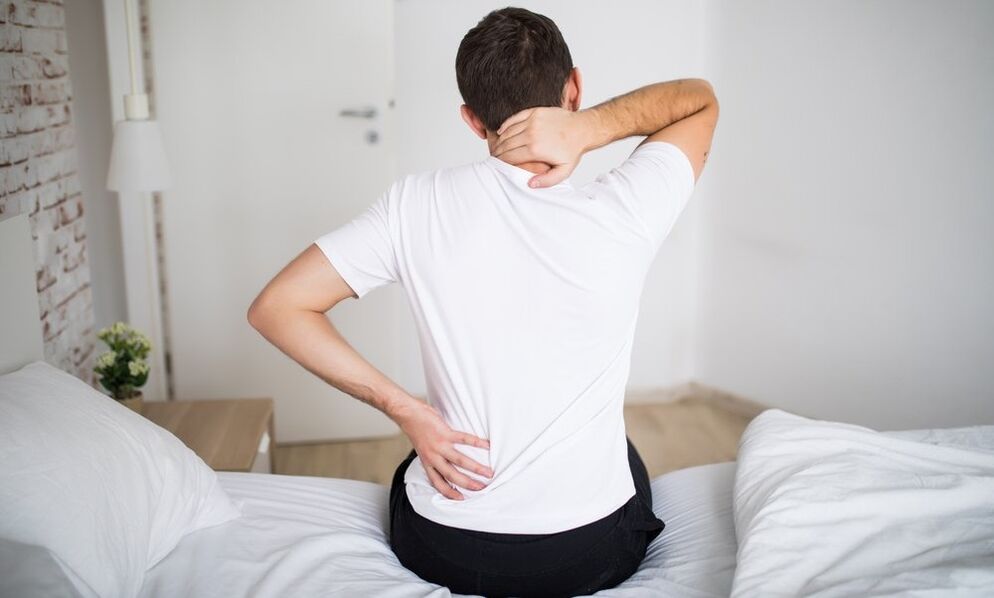Back pain is a symptom that accompanies various diseases and illnesses. In most cases, back pain is a reflection of changes in bone pathology, spinal joints and surrounding tissues, muscles, nerve trunks, and skin on the spine. Back pain may also accompany other diseases, including visceral diseases.

Back pain symptoms
Depending on the cause, back pain can have its own characteristics. In rheumatism, the following symptoms can be distinguished:
- Pain occurs in the lumbar spine, buttocks, and thighs;
- Pain worsens at rest and less pain during exercise;
- Pain accompanied by morning stiffness of the lumbar spine;
- The failure of the spine is bilateral.
As the infection process:
- Severe pain in the spine;
- There are lesions in the waist, and the pain radiates to the hips and legs;
- Pain increases with pressure in the affected area;
- Frequent notice of swelling and redness of the skin in the affected area;
- The procedure is usually unilateral (on one side of the spine).
Muscle pathology:
- For fibromyalgia, the pain is continuous and extensive, covering the left and right halves of the body above and below the waist. It will be exacerbated by emotional and mental overload, cold temperatures and sudden changes in climate. Pain points appear in different anatomical parts, and pressing will reveal them;
- The tension of the affected muscle;
- Muscle strength decreases.
Disc herniation (osteochondrosis), spondyloarthropathy:
- Back pain caused by pressure on the spine (for example, standing upright for a long time), turning back and bending backwards, it is exacerbated when passing through at rest;
- Discomfort may occur when staying in one position for a long time;
- A hernia or joint subluxation may compress nerves. In this case, pain in the arms, occiput (cervical spine injury), and legs (lumbar spine injury), accompanied by numbness, tingling, and muscle weakness in the legs or arms;
- Subluxation of the cervical joints can squeeze the vertebral arteries, causing headaches, dizziness, movement, vision, and hearing coordination disorders;
- The stiffness of the spine disappeared after warming up.
With visceral damage:
- Kidney pathology, except for low back pain and abdominal pain, frequent urination may occur;
- In pancreatic diseases-the surrounding nature of pain;
- Lung disease-Pain in the back or front of the back and chest, under the shoulder blades, and increased coughing.
reason
The causes of the disease are very diverse.
- Back pain caused by pathology of the spine (bones, ligaments, tendons, intervertebral discs):
- Osteomyelitis (a process of infection and inflammation that affects the bone marrow and then the bone tissue composition);
- Spinal tumors and metastases ("screening" for tumors in any organ that has spread to the spine and formed new lesions);
- Herniated disc (osteochondrosis);
- Osteoporosis (a disease characterized by increased fragility of bone tissue);
- Spondylolisthesis (displacement of one vertebra relative to the other vertebrae);
- Scoliosis (curved spine);
- Spondyloarthropathy (a disease based on the failure of all components of the joint, mainly articular cartilage);
- fracture;
- Spinal stenosis (obstruction).
- Back pain caused by muscle abnormalities:
- Fibromyalgia (complex symptoms, manifested as chronic systemic (spreading to many muscles) muscle pain, depression, sleep disturbance, morning stiffness, rapid fatigue);
- Muscle cramps;
- Stretch the muscles.
- Back pain caused by other conditions:
- Pelvic bleeding;
- Festering hematoma in the retroperitoneal space (accumulation of inverted blood);
- Pelvic organ diseases;
- Aortic dissection;
- Kidney disease;
- Abdominal organ diseases;
- Rheumatism (ankylosing spondylitis (a disease characterized by inflammation of the spine and joints), reactive arthritis (a contagious inflammatory disease of the joints), psoriatic arthritis (inflammation of the joints with scalyThe appearance of plaques) skin));
- Shingles, shingles.
- The predisposing factors can be:
- Hurt;
- weightlifting;
- Unprepared action
- Being in a non-physiological (uncomfortable) position for a long time;
- Low temperature.
- Complaint analysis (spine pain, back discomfort when exposed to one location for a long time, morning stiffness; numbness, tingling, muscle weakness in the arms or legs).
- Analyze the medical history (development history) of the disease-ask how the disease started and progressed.
- General examination (inspection and palpation of the spine to determine the range of motion of the spine).
- General blood and urine tests to determine the course of infection and kidney pathology.
- Spine X-ray examination-allows you to detect pathological changes in the vertebrae.
- Computerized magnetic resonance imaging of the spine-allows you to determine the nature of the lesions in the spine and surrounding tissues in more detail.
- EMG-to detect muscle pathology.
- Radioisotope bone imaging is a comparative study based on observing the distribution characteristics of the contrast agent introduced into the body in the bone. Excessive accumulation of lesions indicates the existence of pathological processes.
- Density determination-determination of bone density. It is used to detect osteoporosis (a disease characterized by increased bone fragility).
- Consult a neurologist, chiropractor, rheumatologist, orthopedist.
- Treat underlying conditions that cause back pain.
- Rest for a few days (2 to 5 days).
- Wear a bandage (corset) to relieve the spine.
- Non-steroidal anti-inflammatory drugs (oral, injectable form, topical drug form-ointment, gel)-relieve pain.
- Muscle relaxants are muscle relaxants.
- Surgical treatment based on the cause of the pain-for example, removing purulent foci in the spine; installing prostheses between the vertebrae to restore the normal distance between them, while reducing the intervertebral fissure and compressing the nerve trunk.
- After the acute pain disappears-physical therapy procedures (need to consult a physical therapist), massage, physical therapy exercises.
- It depends on the cause and severity of the disease causing the pain.
- The transition of the disease to a chronic form (osteochondrosis) is possible.
- In severe cases, disability (traumatic injury, rheumatism).
- Treat underlying diseases.
- Eliminate injuries, body overload, and hypothermia.
- Correct posture.
- Correctly arrange work and sleeping places (excluding non-physiological positions of the spine, where it is bent).
- Correct the excess weight.

























